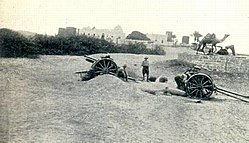
Back جنوب الجزيرة العربية في الحرب العالمية الأولى Arabic حیجاز-یمن جبههسی AZB Паўднёвааравійскі фронт Першай сусветнай вайны Byelorussian Паўднёваарабійскі фронт (Першая сусьветная вайна) BE-X-OLD Histoire de l'Arabie du Sud durant la Première Guerre mondiale French המצור על עדן HE Campagna di Aden Italian د لومړۍ نړیوالې جګړې پر مهال سویلي عربستان Pashto/Pushto Южноаравийский фронт Первой мировой войны Russian Hicaz-Yemen Cephesi Turkish
| Campaign in South Arabia | |||||||
|---|---|---|---|---|---|---|---|
| Part of Middle Eastern theatre of World War I | |||||||
 A QF 15 pounder emplacement of B Battery, Honourable Artillery Company at Sheik Othman in 1915 | |||||||
| |||||||
| Belligerents | |||||||
|
|
| ||||||
| Commanders and leaders | |||||||
|
| ||||||
| Strength | |||||||
|
14,000 Ottoman regulars Yemeni irregulars |
| ||||||
| Casualties and losses | |||||||
| 500–1,000 |
647 killed/missing 584+ wounded 32 captured | ||||||
The campaign in South Arabia during World War I was a minor struggle for control of the port city of Aden, an important way station for ships on their way from Asia to the Suez Canal. The British Empire declared war on the Ottoman Empire on 5 November 1914, and the Ottomans responded with their own declaration on 11 November. From the beginning, the Ottomans had planned an invasion of Britain's Aden Protectorate in cooperation with the local Arab tribes. The Ottomans had gathered in some strength on the Cheikh Saïd, a peninsula which juts out into the Red Sea towards the island of Perim.[5]
At the start of the war, the British had one force stationed in the Aden Protectorate, the Aden Brigade, which was part of the British Indian Army. In November 1914, an Ottoman force from Yemen attacked Aden, but was driven off by the Brigade.[6] Although fighting in South Arabia effectively ceased after June 1916, the last Ottoman troops did not surrender until March 1919.
Cite error: There are <ref group=lower-alpha> tags or {{efn}} templates on this page, but the references will not show without a {{reflist|group=lower-alpha}} template or {{notelist}} template (see the help page).
- ^ "41st Weekly Letter". Aden Residency. 9 October 1915.
- ^ Mehra, Ram Narain (1988). Aden & Yemen, 1905-1919. Agam Prakashan. p. 125.
- ^ "Statistics of the Military Effort of the British Empire" (London: HMSO, 1920). Page 777. 8,219 British and 26,205 Indian troops sent to the "Aden Theatre" from India in total.
- ^ "Statistics of the Military Effort of the British Empire" (London: HMSO, 1920). Page 778. Considering age of figures, may be underestimated. Details for British Indian Army forces in Aden: 7 officers, 500 other ranks, and 79 followers dead from all causes. 16 officers, 548 other ranks, and 4 followers wounded. 1 officer, 15 other ranks, and 3 followers missing. 6 other ranks taken prisoner. Details for British Indian Army forces in Maskat: 1 officer, 39 other ranks, and 2 followers dead from all causes. Unknown officers and followers and 16 other ranks wounded. 1 officer and 25 other ranks taken prisoner.
- ^ McKenzie, F. A. "The Defence of India". The Great War: The Standard History of the All-Europe Conflict. H. W. Wilson, ed. Vol. 7, chapt. 128. This text is now in the public domain.
- ^ Richard J. Shuster, "Aden". The Encyclopedia of World War I: A Political, Social and Military History, Volume 1, Spencer C. Tucker, ed. (Santa Barbara: ABC-CLIO, 2005), p. 37.